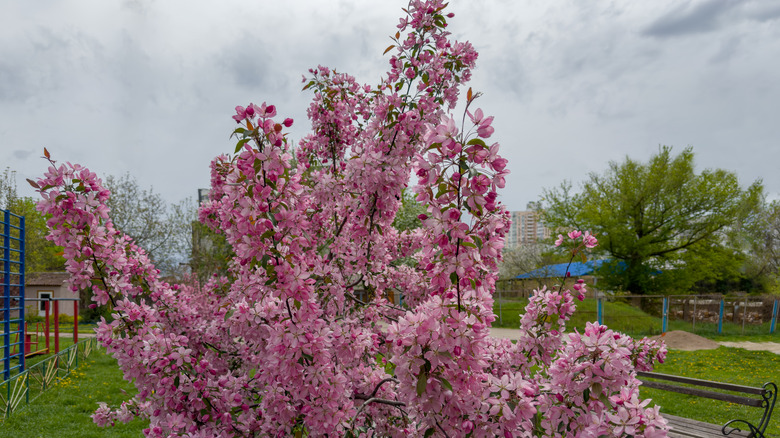The Startling Reason Why Your Spring Plants Could Be Blooming In The Fall
The wonder of gardening is the variety of plants and how each blooming time aligns to a specific season. Spring plants offer beautiful blooms in pink and other pastels, while the rich color of autumn blooms give rich shades of orange, red, and yellow. Professional and amateur gardeners alike know what they can expect for flowering in certain plants, such as crabtree flowers or apple trees in the spring. Likewise, they know what plants typically don't flower in the fall. However, you might plant the vibrant Eastern redbud to bring stunning color to your spring landscape only to discover that yours is actually blooming in the fall. Why? The startling reason why your spring plants could be blooming in the fall comes down to rain, or lack of it. Plants can go into stress due to water scarcity from significant summer droughts. As a result, drought stress may force plants out of dormancy, a period marked without active growth , which triggers blooms in the fall.
Plants such as flowering trees can enter into dormancy as a reaction to the lack of water, and scientists believe the reaction occurs as a way for plants conserve energy. It's no surprise that some avid gardeners report spring plants bursting into bloom in the fall. According to The National Integrated Drought Information System (NDIS) and the National Oceanic and Atmospheric Administration's (NOAA) October 2024 drought report, August through October had record record dryness occurring locally in the Plains, Southwest, Upper Midwest, and Northeast regions of the United States. This year, the world also had its hottest summer on record in over 145 years, per NASA. Global warming and climate change may continue to influence weather patterns with drier summers as well. If you live in a drought-prone area, there are steps you can take to protect your plants and reduce the effects of drought stress.
Identify signs of drought stress and protect your plants
If your area suffers drought or near-drought conditions, you might see signs of stress in your plants. Common signs of drought stress include drooping leaves, crispy leaves, wilting, and changes in leaf color, especially in trees. The plants may also display bare areas, dead flowers, lack of new growth, and insect damage. Watching for these signs can help you approach and manage drought stress' toil on your plants. If your plants have limited access to water, avoid applying too much fertilizer to help with conservation and weed often, especially with landscape plants.
Studies show hydrogen peroxide is a key to manage and prevent drought stress in plants, as its presence helps send signals when stress is present in the plants' membrane. Try mixing 1 gallon of water with 1 tablespoon of hydrogen peroxide, then spraying it gently on the plants when you detect signs of stress. You can also follow a vigorous watering schedule during their blooming season to ensure your trees and shrubs receive at least 1 inch of water a week. If you continually see the effects of drought stress on your plants, especially if it causes spring plants to bloom in the fall, consider adding a few drought-resistant plants that will thrive without much water to your garden.

